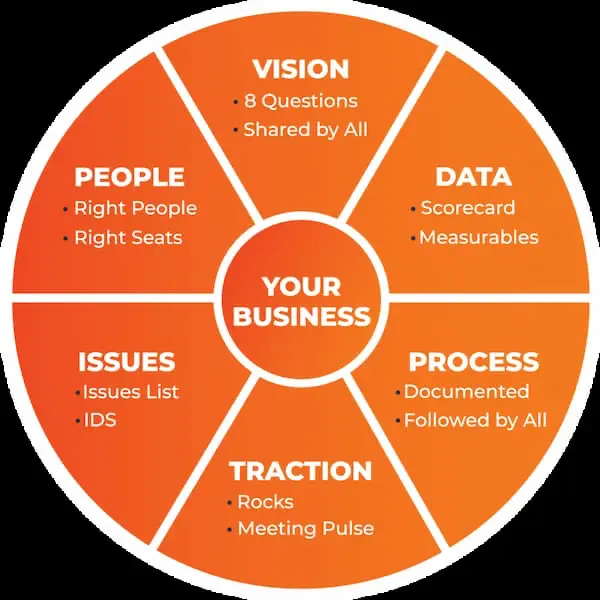Entrepreneurial Operating System (EOS): An Entrepreneurial operating system represents the foundational elements of a business for a founder. We are aware of some of the terms as Business Modle Canvas, business plan, pitch deck etc. They represent the strategic side of a business. However, while you do the strategic work, the operational work cannot be compromised.
The entrepreneurial operating system gives a strategic view of operational elements of the business. If we draw a parallel with the operating system in technology, the EOS is about creating a platform for you to build, grow and expand your business depending on which stage you’re in. It creates the right foundation for you to take your business to the next level as an entrepreneur.
What is Entrepreneurial Operating System (EOS)
As the name suggests, the Entrepreneurial Operating System (EOS) is a group of tools, processes and frameworks that help you develop a business idea. As a founder in early stages, it helps you think about the various aspects of running a business which further enables you to create a good business plan or a pitch deck. It goes beyond a high-level strategy to start thinking about the operational elements that make the business idea a reality.
The entrepreneurial operating system has 6 parts as shown in the diagram below. It all starts with the vision, having right teams, processes, challenges and opportunities. However, the EOS creates a map of these things similar to a business model canvas to give visibility for everyone involved in the business.

EOS Vision
This is where your business idea starts. The EOS demands that you go beyond just the idea to think about how it will serve the market. It also makes you think about the future of a business when it becomes a success. Everyone involved in the process is aware that this is a hypothesis and plans will change. However, the vision helps people understand the direction you’re thinking about the business. It gives the team something to aspire for and for the investors, it creates an idea about the ambition that you have which can serve as a good investment for their funds with capability for returns in an exponential manner.
People
This is all about your entrepreneurial team. If you’ve ever done a pitch to investors, you’ll have noticed that most investors place high importance on the founding team. They’d like to know the experience of the team, their capability and previous experiences. A good team is an indicator that you’ve got people of certain capabilities believing in your idea.
It also acts as a strong endorsement for an investor that you’ve managed to convince some stellar characters about the capability of a business idea. It is not as impactful as sales or signed contracts, but can equally be powerful in the early stages of fundraising with investors. Also, it is important to have the right people because they have the power to either make or break the business idea. Hence its significance in the entrepreneurial operating system.
Data in Entrepreneurial Operating System
No one believes in gut feeling or tacit knowledge while convincing investors, VC’s or even early adopters. People are interested in data. For an investor, they’ll be interested in the market size, capability of the business to create rewards for the investment and the ability to disrupt the market. For customers, it is about ensuring that your idea remains in the market and serves as a proof of continuity. For a team that joins your startup, they want to know that it will survive. For all these conversations, data is a powerful influencer, it goes well beyond the gut feeling of a founder and acts as proof in early stages of business plan building.
The Process
People tend to think that entrepreneurship is agile and everything keeps changing. Although it is true, entrepreneurship will fail if you don’t create processes that can scale the business idea. Investors will not be interested in a business idea that can’t scale or else it becomes a small business. Make sure that these processes don’t depend only on the founder. INvestors are smart, they don’t want to waste their time and money on things that don’t create compelling value or returns.
Traction
This is the only proof you have as a leading indicator for sales projections. During the early stages in a startup, we know that there aren’t many sales. Hence, investors will rely on identifying traction which acts as an indicator that people are interested in your business idea. Sometimes these tractions are in the form of MOU’s, early agreements with customers, contracts without enforcement etc. It can also be as basic as the number of hits on a website, time people spend reading your idea. The traction is all about an indicator that customers are interested in your idea.
Conclusion: Entrepreneurial Operating System (EOS)
As you can see, the EOS covers multiple parts of your business idea. But these are the core areas that define whether a business has the potential to succeed or not. These areas keep evolving in their definition as your business grows. It is important to note that the EOS is a supplementary process along with all other activities that you perform as a founder. An Entrepreneurial Operating System can be most valuable in the startup pitches and funding conversations. It helps the investors realise that you’ve thought about the business and give them confidence about investing in your idea.
